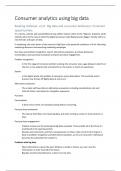Summary
Summary of articles and lectures Costumer analytics using Big Data
- Course
- Institution
Handy summary of all articles and lectures for the course Costumer Analytics using Big Data from the Economic Psychology master. The lectures were given by the professor. The summary may also help because you don't necessarily have to read the full articles. Good luck!
[Show more]



